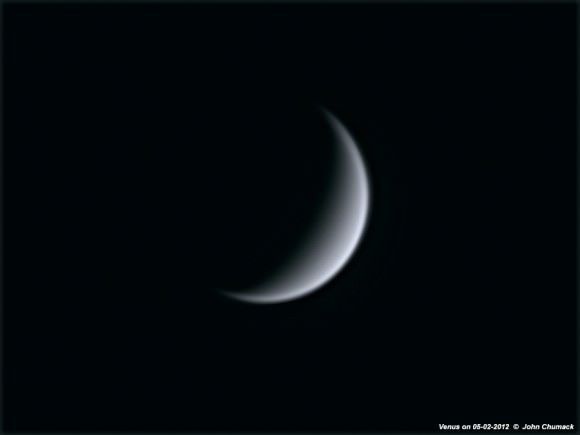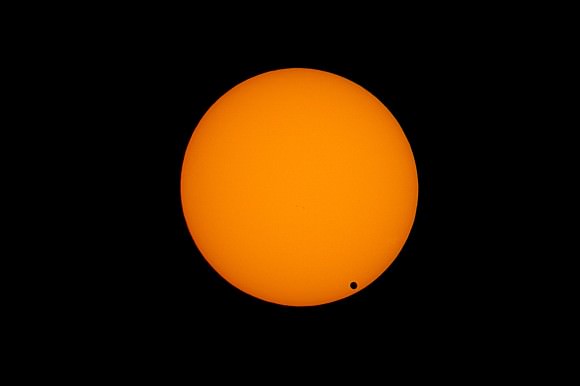
Venus 34 Days Before 2012 Transit - Credit: John Chumack
Head outside on any clear night this week and you won't be able to miss brilliant Venus decorating the western horizon. Right now it's surrounded by a host of bright winter stars like Capella, Betelgeuse, Aldebaran and the Pleiades. But, don't stop there. Use any type of optical aid and you'll see the planet is in the crescent phase right now and bigger than Jupiter in apparent size!
There's a lot of things to know about viewing Venus. Oddly enough, the smaller the phase, the more brightly it shines. If you cannot see its slender form for the glare, simply try wearing sunglasses while using your binoculars... or stacking dark filters, such as green and blue, for the telescope eyepiece. While you'd think that something which sparkles and shines like Venus would be very exciting to see magnified, it's actually pretty bland. However, don't let rather ordinary appearances fool you. Behind that "girl next door" exterior is a really radical chick. Beneath the bland clouds runaway greenhouse gases heat things up to 860 degrees Fahrenheit (460 degrees Celsius) and volcanoes rule.
Keep on watching Venus. Right now she's headed towards Earth and the pinnacle of observing excitement - the Transit. It will continue to grow larger in apparent size and the crescent phase will narrow even more. On June 5 (June 6 in Australia and Asia), it will pass between the Earth and Sun... an event which only happens about twice and century and won't happen again until the year 2117!

The clock is ticking and now is the time to begin your preparations to view the transit of Venus. Do not wait until just a few days before the event to choose a location for your observations. If you do, you might find yourself faced with clouds... an obstruction you hadn't planned on... getting permission to be in a certain area... or many other things. Knowing exactly where the Sun will be during the transit means a relaxed experience!
As of now, you're going to find it will be very difficult to locate solar filters for particular telescopes - and waiting any longer may mean not having one at all. Because the transit of Venus is such a rare event, many retailers are carrying special eclipse/transit viewing glasses. They will appear much like the cardboard 3D glasses you get at the movie theatre, but instead of red and blue lenses, they will have either black mylar or Baader filter film. These glasses are safe for solar viewing, but there are a few things you must understand about them. Before you view, please inspect the edges carefully to make sure they are sealed and no sunlight can enter. Even more importantly, do not use them in conjunction with binoculars or a telescope. Eclipse glasses were meant strictly for use with your eyes. Concentrating sunlight with an optical aid and hoping the glasses will be enough to block the Sun's harmful rays is taking a chance at blinding yourself. Always use approved solar filter material when viewing with telescopes or binoculars and always supervise when children are present.

The next tip for viewing the Venus transit has to do with photography. If you plan on filming or photographing the event through a telescope, now is the time to practice. Do not wait until just a few days before the event to be sure your video equipment is working properly - or that your camera is prepared. Start now by taking practice pictures of the Sun and make sure you have spare batteries or a power supply on hand for the day of the event. Nothing is more disappointing than being ready to photograph an astronomical event and having your equipment fail at the last second. It's always wise to have a back-up option... such as a cell phone camera, spare pocket camera, or even a camcorder handy just in case. All of these will work afocally. If you practice in advance, you'll find you can take quite satisfactory photos by just holding the camera to a properly solar filtered telescope eyepiece.
The last tip for viewing the Venus transit is time. Make sure well in advance of exactly what time the transit starts in your area! The local transit times page by Steven van Roode and Francois Mignard is an excellent resource. But don't forget... the times are given on an astronomical standard - Universal Time. If you are unsure of how to convert, try the Time Zone Converter to assist you.
The clock is ticking... Be ready!
Written by Tammy Plotner
No comments:
Post a Comment